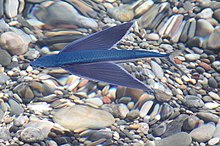
The Tetraodontiformes are an order of highly derived ray-finned fish, also called the Plectognathi. Sometimes these are classified as a suborder of the order Perciformes. The Tetraodontiformes are represented by 10 extant families and at least 349 species overall; most are marine and dwell in and around tropical coral reefs, but a few species are found in freshwater streams and estuaries. They have no close relatives, and descend from a line of coral-dwelling species that emerged around 80 million years ago.
Hemiramphidae is a family of fishes that are commonly called halfbeaks, spipe fish or spipefish. They are a geographically widespread and numerically abundant family of epipelagic fish inhabiting warm waters around the world. The halfbeaks are named for their distinctive jaws, in which the lower jaws are significantly longer than the upper jaws. The similar viviparous halfbeaks have often been included in this family.

Cirrhitidae, the hawkfishes, are a family of marine perciform ray-finned fishes found in tropical seas and which are associated with coral reefs.
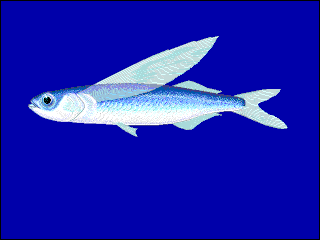
Beloniformes is an order composed of six families of freshwater and marine ray-finned fish:
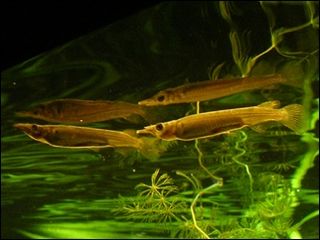
The wrestling halfbeak also known as Malayan halfbeak is a species of viviparous halfbeak native to the fresh and brackish waters of rivers and coastal regions in South-East Asia, in Singapore, Thailand, Indonesia, Thailand, Malaysia, Borneo and Sumatra. It is a small, slender, livebearing fish, with the elongated lower jaw characteristic of its family. The colour of this species varies, depending on where the specimen is found. It is the type species of the genus Dermogenys.

Needlefish or long toms are piscivorous fishes primarily associated with very shallow marine habitats or the surface of the open sea. Some genera include species found in marine, brackish, and freshwater environments, while a few genera are confined to freshwater rivers and streams, including Belonion, Potamorrhaphis, and Xenentodon. Needlefish closely resemble North American freshwater gars in being elongated and having long, narrow jaws filled with sharp teeth, and some species of needlefishes are referred to as gars or garfish despite being only distantly related to the true gars. In fact, the name "garfish" was originally used for the needlefish Belone belone in Europe and only later applied to the North American fishes by European settlers during the 18th century.
Sauries are fish of the family Scomberesocidae. There are two genera, each containing two species. The name Scomberesocidae is derived from scomber and the Latin esox meaning pike.
The ballyhoo halfbeak or ballyhoo is a baitfish of the halfbeak family (Hemiramphidae). It is similar to the Balao halfbeak in most features. Ballyhoo are frequently used as cut bait and for trolling purposes by saltwater sportsmen. The fish is reported to have caused ciguatera poisoning in humans.
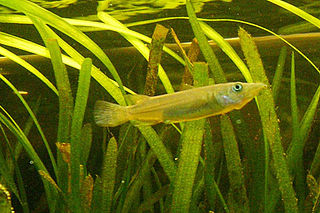
Nomorhamphus is a southeast Asian genus of viviparous halfbeaks from streams, rivers and lakes in Sulawesi (Indonesia) and the Philippines. They are all viviparous, producing small clutches of around a dozen fry about 10 to 15 mm long at birth. Females are generally larger than the males. In the largest species, such as Nomorhamphus liemi, the females typically reach about 10 cm (3.9 in) in length, whereas the males reach about 6–7 cm (2.4–2.8 in) in length. Males are also more brightly coloured than the females. Compared with many other halfbeaks, the lower mandible, or beak, is relatively short, on females in particular barely protruding beyond the length of the upper mandible. The males of some species have short, straight beaks, but those of others have short beaks that curve downwards forming a shape often compared to a goatee beard by aquarists. N. aenigma is unique within Nomorhamphus because of its lack of lower jaw elongation.
This glossary of ichthyology is a list of definitions of terms and concepts used in ichthyology, the study of fishes.

Acanthopterygii is a superorder of bony fishes in the class Actinopterygii. Members of this superorder are sometimes called ray-finned fishes for the characteristic sharp, bony rays in their fins; however this name is often given to the class Actinopterygii as a whole.

Euleptorhamphus is a genus of halfbeaks in the order Beloniformes.

Cryptacanthodes is a genus of marine ray-finned fishes belonging to the monogeneric family Cryptacanthodidae, commonly referred to as wrymouths. Three of the four species are found in the Pacific Ocean with one species native to the western Atlantic Ocean where they are benthic fishes, tunneling through soft substrates. It is currently the only known genus in its family.
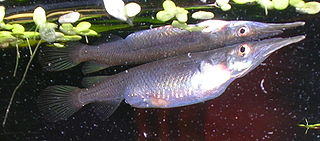
Zenarchopteridae, the viviparous halfbeaks, is a family in the order Beloniformes. The Zenarchopteridae exhibit strong sexual dimorphism, practicing internal fertilisation, and in some cases ovoviviparous or viviparous. The members in the family are mainly found in fresh and brackish water of tropical Asia and New Guinea, but the genus Zenarchopterus also includes marine species from the Indo-Pacific. Several, such as the wrestling halfbeak, have become commonly traded aquarium fish.
The feathered river garfish, also known as the estuarine halfbeak, spoon-fin garfish, spoon-fin river garfish and viviparous half beak, is a species of marine, freshwater, brackish and reef-associated oceanodromous viviparous halfbeak found in Indo-Pacific regional countries, such as Kenya, Mozambique, Seychelles, Madagascar, New Guinea, Solomon Islands, Australia, New Caledonia, Fiji, Sri Lanka, India, Vanuatu, Malaysia, Thailand, Singapore and Samoa.

Nomorhamphus ebrardtii is a species of viviparous halfbeak, a ray-finned fish in the family Zenarchopteridae, endemic to brackish and freshwater locations in Sulawesi and the neighbouring island of Kabaena in Indonesia. This species can reach a length of 9 cm (3.5 in) SL.

Hemiramphus far, the halfbeak, black-barred halfbeak, black-barred garfish, barred halfbeak, barred garfish or spotted halfbeak, is a schooling marine fish belonging to the family Hemiramphidae, the halfbeaks. It has an Indo-Pacific distribution and has invaded the eastern Mediterranean through the Suez Canal.
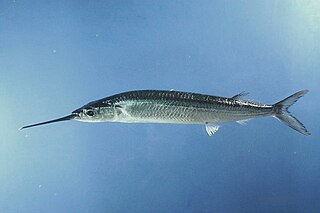
Hyporhamphus unifasciatus, the common halfbeak or the Atlantic silverstripe halfbeak, is a bony fish in the family Hemiramphidae. It is found in the subtropical western Atlantic Ocean and the Gulf of Mexico. It is a common fish and not used for food to any great extent, and the International Union for Conservation of Nature has listed its conservation status as being of "least concern".

Ovalentaria is a clade of ray-finned fishes within the Percomorpha, referred to as a subseries. It is made up of a group of fish families which are referred to in Fishes of the World's fifth edition as incertae sedis, as well as the orders Mugiliformes, Cichliformes, and Blenniiformes. It was named by W. L. Smith and T. J. Near in Wainwright et al. (2012) based on a molecular phylogeny, but the authors suggested that the group was united by the presence of demersal eggs that are attached to a substrate. Some authors have used the ordinal name Stiassnyiformes for a clade including Mugiloidei, Plesiopidae, Blenniiformes, Atherinomorpha, and Cichlidae, and this grouping does appear to be monophyletic.
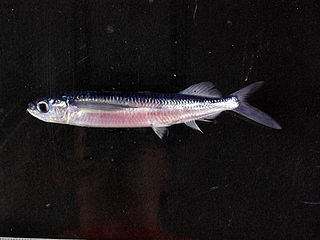
Exocoetoidei is a suborder of the order Beloniformes, which is sometimes known as the Belonoidei. It contains two superfamilies and five families.
